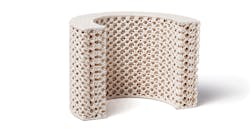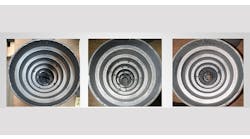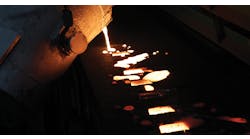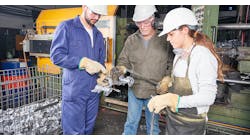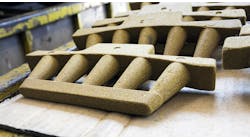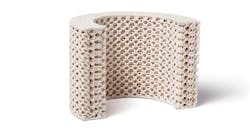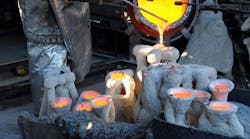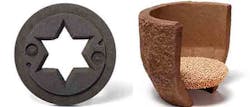Pouring Over Options to Enhance Casting Yield and Cleanliness
Q: We are looking for a way to improve yields for the large castings we pour. But, we also need to improve the cleanliness of finished castings. How should we approach these two objectives?
A: When improving casting yields and casting cleanliness direct pouring cups become extremely useful. These cups can be produced either with standard fiber-based products or core-shot alumina microspheres. Using a direct pouring cup in conjunction with a filter and breaker core will give you the best chance to achieve the productivity and product quality results you seek.
Standard, fiber-based insulating pouring cups are made with highly refractory alumina fiber. These materials are sufficiently robust to handle direct metal impingement while maintaining a low density, to ensure requirements for beneficial feeding. Paired with reticulated ceramic filters, this technology makes it possible to implement a feed/fill mechanism will calm the flow of a molten metal stream as it enters the casting cavity. The tapered filter is designed to float after pouring, and once it reaches the top of the riser it can be removed from the sleeve — and save more metal for reuse.
Typical filter/sleeve combinations are determined according to the specific alloy and casting feed requirements. Standard matches of filters and alloys include:
- Silicon carbide (SiC) filters for Iron and non-ferrous alloys;
- High-temperature zirconia (ZR) or carbon-bonded alumina refractory for steel alloys.
The choice of filter for a steel casting application is based entirely on the temperature and fluidity of the alloy. Lower-temperature alloys (2,880°F and below) tend to require a carbon-bonded (CB) filter to aid in the task of filter priming. Regular steel pouring temperatures (above 2,880°F) typically have enough thermal energy and fluidity to prime zirconia (ZR). Zirconia filters are a stronger and more efficient filter materials, so this material should be used whenever possible.
Sleeves are chosen according to the feed requirements for the casting. Pouring cups are available in standard sizes from 2 through 6 inches; 2x6, 2.5x6, 3x6, 4x6, 5x8, and 6x9-inch models are the most common.
In some applications, the standard direct-pouring products are not large enough to handle the feeding requirements and/or the capacity requirements of the casting. Sometimes these applications may be enhanced by using a tapered filter, coupled with neckdown riser sleeves. Neckdown riser sleeves allow for a very effective modulus in a direct pouring process.
Using a breaker core significantly reduces the cleaning time of the casting. Standard core removal takes time (and time is money) — so instead of cutting the core off the casting, a breaker core can be removed with a hammer blow, saving time and leaving a smaller area to be polished. Breaker core designs can be customized to meet the needs of the customer.
A customized tapered filter gives foundries the benefit of creating the most cost-effective direct pouring system for their requirements. It is critical to remember to avoid a metal drop of more than 12 inches after it exits the filter, and to allow filter flotation whenever possible. This will allow the maximum cross-sectional area of riser contact, and promote the most repeatable riser performance.
Using all three technologies is the best way to ensure you improve casting yields and enhance the cleanliness of the finished parts, so let ASK Chemicals help you make the best casting possible.
Join the Conversation. Email Your Questions for ASK Chemicals
Share your insights, opinions, and elaborate on the questions and the experts' answer(s). You must be logged in to the website in order to post your comments.
